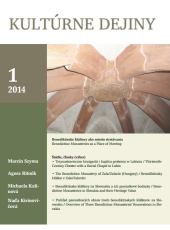Benediktínsky kláštor v Zale/Zalavári
The Benedictine Monastery of Zala/Zalavár (Hungary)
Author(s): Agnes RitoókSubject(s): History
Published by: VERBUM - vydavateľstvo Katolíckej univerzity v Ružomberku
Keywords: medieval; Zalavár; monastery; inventory; precinct wall; stone carvings with interlace decoration; churchyard analysis
Summary/Abstract: The Benedictine monastery dedicated to St. Adrian of Zala was founded by the first Hungarian king, St. Stephan, in 1019 on the Castle Island, above the remains of 9th century Mosaburg, in the confines of Zalavár. The abbey survived until 1948, though from the 18th century onwards it functioned in new relationships and on another locality. Documentary evidences (charters, inventories and a survey) on the monastic buildings, liturgical fittings and the library originating in the late medieval period are discussed in this paper. The medieval buildings themselves were demolished in the 18–19th centuries. Some details were still surveyed in the 19th century. The sole architectural remains – timber based foundations of a precinct wall and of a gatehouse – were uncovered by the excavations in 1951–1954 and 1963–1965. The new excavations from 1995 onwards have not reached the foundations yet, but the debate on the interpretations of the excavated remains and on the exact locality of the late medieval building complex, together with the question of dating, have already been settled by their results. The architectural shine of the buildings inside of the precinct wall is fragmentary reflected by the stone carvings of Zalavár provenance of the 11–13th centuries. The re-use of some 9th century pieces in the 11th century monastery has been proven by the finds of the excavations within the last twenty five years. The analysis of the excavated part of churchyard gave a possibility to reconstruct a small detail of the 11th century environment, the communication and also the process of Christianisation. The paper summarizes the plans and realization of the monuments and the reconstruction of their remains on site.
Journal: Kultúrne dejiny
- Issue Year: 2014
- Issue No: 1
- Page Range: 19-47
- Page Count: 29
- Language: English

